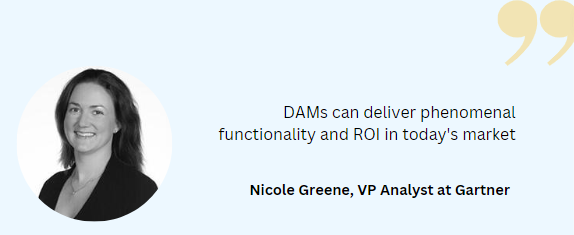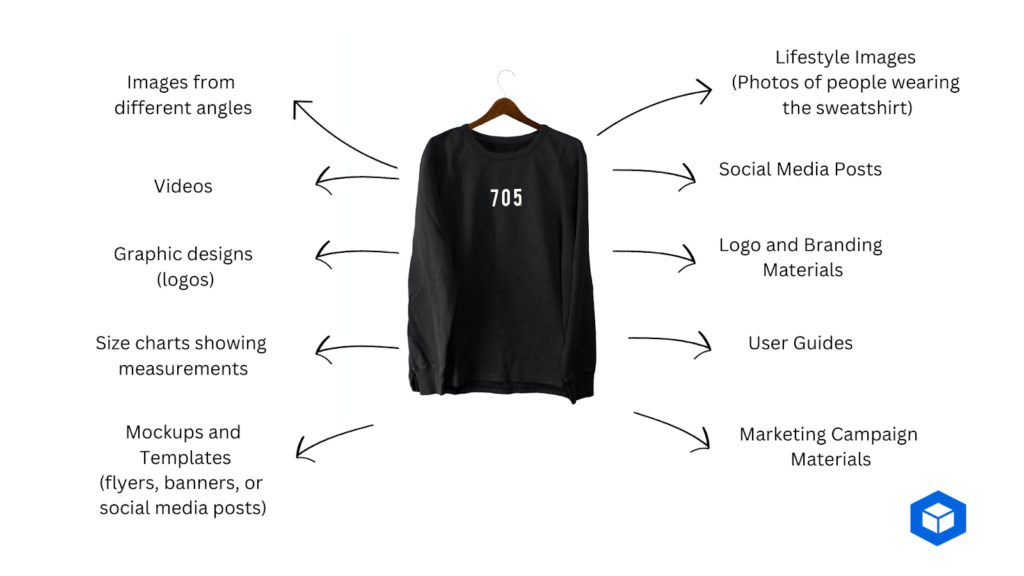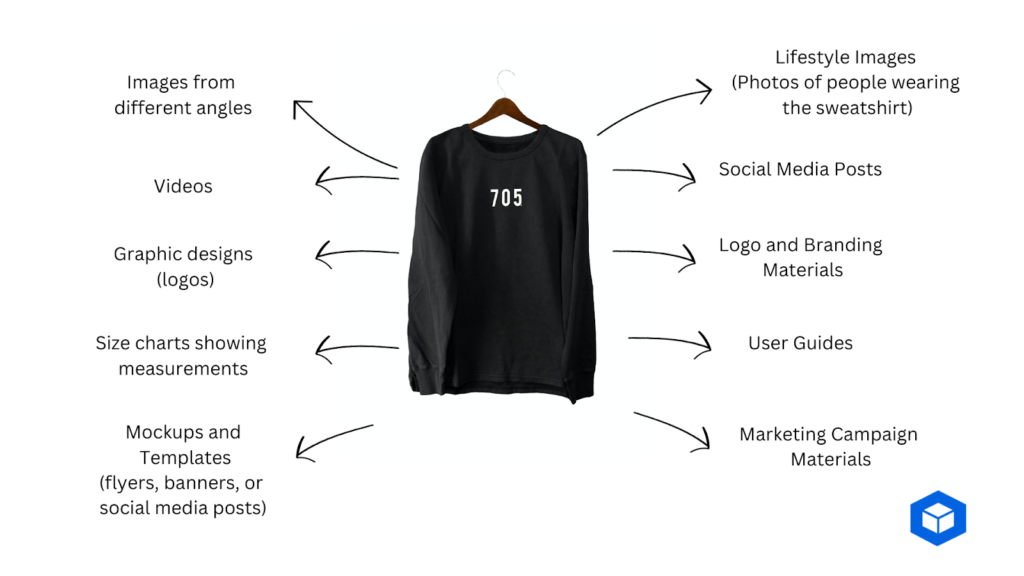A shiny product page looks so effortless from the point of view of the customers. They see all the relevant information and attractive media assets that help them make an informed decision.
Feels like *swish and flick* of a magical wand.

As a seller, only you know it wasn’t easy to get there.
From the spreadsheets that gave you jump scares and the ERP systems that made you go through countless cups of midnight coffees, product data management is far from being a painless task.
Managing textual content combined with visual elements makes the task even more painful if you don’t have a PIM and DAM in place.
If you’re unsure what is PIM, what is DAM, and how they differ from each other (PIM VS DAM). Let’s dive right in!
PIM VS DAM: A detailed comparison
Here’s a detailed PIM VS DAM comparison to help you understand how these systems differ with respect to users, use cases, and the type of data managed.
| Aspect | DAM | PIM |
| Primary Focus | Digital asset management | Product data management |
| Data Types Managed | Images, videos, documents, etc. | Product descriptions, attributes, specifications, etc. |
| Primary Users | Marketing, creative teams | E-commerce, retail, and product management teams |
| Use Cases | Asset storage, retrieval, and distribution | Product data enrichment, consistency, and syndication |
| Example Scenario | Marketing a clothing brand | Managing a vast e-commerce product catalog |
Let’s now dive deep into PIM VS DAM.
What is DAM?
Digital Asset Management, often referred to as DAM, is a system that simplifies the process of storing, managing, and retrieving digital assets from a centralized location. Digital assets can include images, videos, documents, audio files, and more.

It is an invaluable tool for marketing and creative teams. Without a DAM, a typical day for them would involve these tasks (a bloated project management board):
Project management tool bloat: A typical day of a marketing/creative team that does not use a DAM
✅ Wake up and start hunting for the digital assets:
Team members start their day by searching through various folders, servers, and personal computers to find the digital assets they need
✅ Begin to lose control over versions:
Without a centralized system, tracking versions of files becomes a challenge. Branding takes a toll because the team starts using outdated assets
✅ Collaboration becomes a joke:
Sharing files often involves manually sending them over an email or other file-sharing services, breaking the communication chain and messing things up
✅ Wasting a ton of time in manual chores:
Valuable work hours are spent on repetitive tasks like renaming files, converting formats, or resizing images to fit specific platforms
✅ Consistency continues to be a dream:
The absence of a single source of truth for digital assets can result in inconsistencies in branding, messaging, and design across different marketing campaigns
✅ Difficulty in asset retrieval:
When spontaneous marketing campaigns are planned asset retrieval becomes difficult thus delaying actions and leading to missed opportunities
✅ Security Concerns:
Managing the security and access control of digital assets can be a concern
In a nutshell, here’s how a DAM can help you – all the media files that you see in a product page (sweatshirt in this example) can be owned, managed, edited, and published from one DAM.

Who uses a DAM?
DAM systems are widely adopted by marketing and creative professionals who deal with a significant volume of digital assets.
Creative teams can store, manage, and access their creative assets and retrieve them easily from a DAM. They’d never have to worry about losing version control and team members can seamlessly collaborate from a single source of truth. This helps marketing teams ensure brand consistency
DAM acts as a portal for suppliers and vendors to upload product images and other assets.
When do you need a DAM?
You need a DAM system when your business handles a large number of digital assets that must be organized, accessed, and shared efficiently. An online business (any industry) – apparel, furniture, FMCG, home goods, etc. needs digital assets to help its customers delve through the product and understand its look and feel in a better way.
For instance, the furniture industry heavily relies on visual assets to showcase products and facilitate sales. Let’s take a specific product, a modern sectional sofa, as an example, and explore the digital assets needed and how to manage them with DAM:
- Multiple high-resolution images of the sectional sofa from various angles, including close-ups that cover any intricate details
- Interactive 360-degree views that allow customers to rotate the sofa and inspect it from all sides to fully comprehend the look and feel
- Videos showcasing the sofa’s features, such as reclining mechanisms, pull-out bed options, and assembly instructions
- Images that depict the sofa in real-life settings, like a living room set-up or in a bedroom
- Variations of the sofa that include colors and materials, leg styles, and optional add-ons like throw pillows
- Digital documents or videos with step-by-step assembly guides to help customers set up the sofa correctly
So, a DAM is inevitable for all online businesses, particularly when they:
- When your company is growing and the number of products starts increasing, your business needs a DAM to manage their digital assets
- If your content is complex with a lot of variations and formats, it becomes difficult to manage them
- When maintaining brand consistency across channels becomes challenging
- When a lot of stakeholders are involved in digital assets, a DAM can ease the collaboration process
What is a PIM?
Product Information Management, or PIM, is a platform that helps eCommerce businesses centrally store, manage, and syndicate product data.

When businesses begin to scale and start adding more products, the number of associated attributes and information begins to expand. For instance, a sweatshirt (like the above) has multiple attributes like brand name, color, size, fabric, care instructions, reviews, etc. that become difficult to handle when the number of SKUs is voluminous.
PIM systems help maintain consistent, accurate, and up-to-date product information that not only simplifies data management but also significantly improves customer experience and revenue.
Here’s how a PIM can benefit your eCommerce business:
- Centrally store and manage product data and make access to any information easy
- Collaborate with internal and external stakeholders and save time and effort in curating the information needed to publish the final catalog
- Ensure that product catalogs have no missing data, and they’re accurate and consistent across channels
- Syndicate content that is compliant with each channel’s unique requirements
- Expand across international markets with product data that caters to different regions and languages
When do you need both DAM and PIM?
An eCommerce business needs a DAM and a PIM in most cases, particularly when their products need media assets to make the product catalogs more engaging and help customers make an informed decision.
They also need a PIM when they have hundreds of thousands of SKUs with a lot of variants and need a PIM to centrally store, manage, and enrich product catalogs. This synergy enhances the overall customer experience.
| Scenario | Explanation |
| E-commerce and Retail | In e-commerce, managing extensive product information (PIM) and a wide range of digital assets (DAM) is crucial for creating rich, accurate, and consistent product listings, and enhancing the customer shopping experience. |
| Large Product Catalogs | Businesses with a vast array of products benefit from using PIM to manage product data and DAM to organize diverse digital assets. This combination ensures accurate and complete product listings. |
| Cross-Channel Marketing | Multi-channel marketing efforts require consistent product data (PIM) and easily accessible digital assets (DAM) for various campaigns across different platforms, ensuring brand consistency. |
| Collaboration and Workflow | Teams working together on products can improve efficiency by using PIM for data entry and validation and DAM for asset sharing and collaboration, streamlining workflows. |
| Regulatory Compliance | Industries subject to strict regulations, like healthcare, can use PIM for data accuracy and DAM for secure storage of compliant assets, ensuring products meet legal requirements. |
| Global and Multilingual Operations | PIM can manage data for multiple regions and languages, while DAM stores localized assets, ensuring the right content is used for diverse markets, and facilitating global operations. |
| Enhanced Customer Experience | Combining PIM and DAM leads to better customer experiences by providing accurate product information and high-quality digital assets, ultimately increasing customer satisfaction and conversions. |
Final thoughts
PIM VS DAM: What’s the right tool for you? Choosing between DAM and PIM depends on your specific business needs. While DAM is ideal for managing digital assets, PIM is tailored for complex product data management.
In some cases, a combination of both can provide a comprehensive solution to meet your business’s requirements. Understanding the distinctions and use cases of DAM and PIM is vital for making informed decisions about which system best suits your organization’s goals. PIM VS DAM is more about understanding the differences, similarities, and synergies of these systems rather than a head-on-head comparison.
Implementing a platform like PIMworks that can help you manage both product information and media assets would help you scale your business, improve time to market, enhance customer experience, and increase your revenue.
FAQs
DAM systems primarily focus on the organization and management of digital assets like images, videos, and documents, while PIM systems are designed for managing product information, including descriptions, attributes, and specifications.
You should consider a DAM system when your main concern is managing a vast collection of digital assets efficiently. On the other hand, if your primary need is to maintain consistent and detailed product data for a wide range of products, a PIM system is more appropriate.
While some software solutions offer combined DAM and PIM features, it’s essential to carefully evaluate your specific requirements. In many cases, businesses benefit from using dedicated DAM and PIM systems to meet their distinct needs effectively.
Businesses that require both DAM and PIM systems often include e-commerce companies with extensive product catalogs. By using both, they can efficiently manage product data and digital assets, ensuring a consistent and compelling online shopping experience.
Both DAM and PIM systems typically offer integration capabilities with various software and platforms, such as e-commerce platforms, content management systems (CMS), and digital marketing tools. The extent of integration can vary, so it’s important to choose systems that align with your existing tech stack and business processes.

![Salsify VS Akeneo: An In-depth Comparison [2024] salsify vs akeneo](https://www.pimworks.io/blog/wp-content/uploads/2023/12/image-9-370x245.png)

![eCommerce PIM: A Comprehensive Guide [Meaning, Benefits, & Popular Tools] pim for ecommerce](https://www.pimworks.io/blog/wp-content/uploads/2023/12/image-10-370x245.png)
